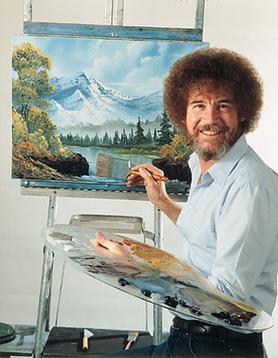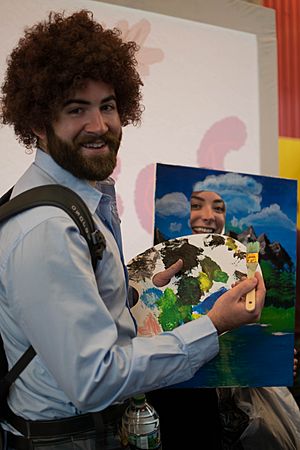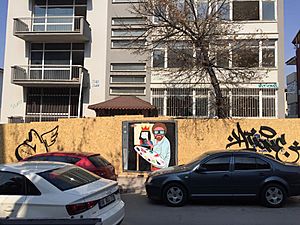Bob Ross facts for kids
Quick facts for kids
Bob Ross
|
|
|---|---|

Publicity photo of Ross with his easel
|
|
| Born |
Robert Norman Ross
October 29, 1942 Daytona Beach, Florida, U.S.
|
| Died | July 4, 1995 (aged 52) Orlando, Florida, U.S.
|
| Resting place | Woodlawn Memorial Park |
| Occupation |
|
| Years active | 1981–1995 |
| Spouse(s) |
|
| Children | 2 |
| Military career | |
| Allegiance | |
| Service/ |
|
| Years of service | 1961–1981 |
| Rank | |
| Battles/wars | Cold War |
Robert Norman Ross (born October 29, 1942 – died July 4, 1995) was an American painter, art teacher, and TV host. He is famous for creating and hosting The Joy of Painting. This was a TV show that taught people how to paint. It aired from 1983 to 1994 on PBS in the United States and other channels around the world. Even after he passed away, Bob Ross became very well-known on the internet.
Contents
Early Life and Military Service
Bob Ross was born in Daytona Beach, Florida, and grew up in Orlando, Florida. His dad was a carpenter and his mom was a waitress. When he was young, Bob loved taking care of injured animals. These included armadillos, snakes, alligators, and squirrels. One squirrel even appeared on his TV show!
Bob left high school in the 9th grade. He worked as a carpenter with his father. During this time, he lost part of his left index finger. But this didn't stop him from holding his palette when he painted later on.
Serving in the Air Force
In 1961, when he was 18, Bob Ross joined the United States Air Force. He worked as a medical records technician. He eventually became a master sergeant. He served in Alaska at Eielson Air Force Base. This is where he first saw the snowy mountains that became a big part of his paintings.
Bob developed his quick painting style during short breaks at work. He had to be tough and strict in his military job. Because of this, he decided he would never raise his voice again after leaving the military.
Becoming a Painter
During his 20 years in the Air Force, Bob became interested in painting. He took an art class at a U.S.O. club in Anchorage. He often disagreed with his art teachers. They were more interested in abstract art and didn't teach how to paint real things like trees.
While working as a bartender, Bob discovered a TV show called The Magic of Oil Painting. It was hosted by a German painter named Bill Alexander. Alexander used a special painting style called "wet-on-wet." This technique allowed him to finish a painting in just 30 minutes.
Bob learned and mastered this technique. He started painting Alaskan landscapes on novelty gold-mining pans and sold them. Soon, he was earning more from his paintings than from his military job. He retired from the Air Force in 1981.
He moved back to Florida and learned more from Bill Alexander. He even worked for Alexander's art supply company. Later, a woman named Annette Kowalski encouraged Bob to start his own business. Bob, his wife, and Annette pooled their money to create his company. It was tough at first.
Bob Ross was known for his permed hair. He actually didn't like it, but he kept it because it became part of his company's logo.
The Joy of Painting Show
The Joy of Painting TV show started filming at the PBS station WIPB in Muncie, Indiana. The show ran from January 11, 1983, to May 17, 1994. Even today, reruns of the show are still shown in many places and on streaming services like Hulu.
In each half-hour episode, Bob taught viewers his quick, wet-on-wet oil painting technique. He would paint a scene without sketching it first. He created the image directly from his imagination in real time. He explained his limited colors and broke down the painting process into simple steps.
Many people compared Bob Ross to Fred Rogers, the host of Mister Rogers' Neighborhood. This was because of Bob's soft voice and calm way of speaking.
With help from Annette and Walt Kowalski, Bob used his TV show to sell art supplies and class recordings. This grew into a big business called Bob Ross Inc. After Bob passed away, the Kowalskis took over the company.
Bob also loved filming wildlife, especially squirrels, in his garden. He often took in injured or abandoned animals. Small animals sometimes appeared in his paintings on The Joy of Painting.
It's believed that Bob Ross painted about 30,000 paintings in his life. Even with so many paintings, original Bob Ross artworks are hard to find for sale. They often sell for thousands of dollars. Bob Ross Inc. still owns many of the paintings he made for the show. Bob didn't want his art to be just about money.
His paintings are most wanted by everyday fans of The Joy of Painting, not by wealthy art collectors.
Painting Technique
Bob Ross used a wet-on-wet oil painting technique. This means he painted new layers of wet paint over a thin, wet base layer. This allowed him to keep painting without waiting for layers to dry. He used simple tools and colors, so you didn't need to buy a lot of expensive equipment. He often suggested using odorless paint thinner to clean brushes.
By combining the wet-on-wet method with large brushes (one-inch and two-inch) and painting knives, he could quickly finish a landscape scene.
Bob painted three versions of almost every painting shown on his program. First, he painted one before filming to use as a guide. Then, he painted the second version live on TV for viewers to watch. After filming, he painted a third, more detailed version for his instructional books. Each version was marked on the back: "Kowalski" for the first, "tv" for the show version, and "book" for the book version.
Artistic Influences
Bob Ross dedicated the first episode of his show's second season to Bill Alexander. He said that Bill taught him the amazing wet-on-wet technique. Bob felt it was a precious gift he wanted to share. As Bob's popularity grew, his relationship with Alexander became difficult.
Art experts have noted that the "wet-on-wet" technique actually started in the 15th century. Many famous artists like Frans Hals and Claude Monet used it.
Bob Ross's Style
Bob Ross was famous for phrases he often said while painting. One popular phrase was "let's add some happy little trees."
In most episodes, Bob would talk about how much he enjoyed cleaning his paint brush. He would dip his brush in odorless thinner and then tap it against the can. Then he would tap it against a box or a trash can. Sometimes he would hit the brush hard on the trash can, saying he would "beat the Devil out of it." He would often smile and laugh when he said this.
Bob always wore jeans and a plain, light-colored shirt on his show. He thought this look would never go out of style. He spoke as if he was talking to just one person watching at home.
When asked why he was so calm, he said, "If you want bad stuff, watch the news." He explained that he painted to create a happy world.
The landscapes he painted often featured mountains, lakes, snow, and log cabins. These were inspired by his time in Alaska. He always said that everyone has artistic talent. He believed that with time, practice, and encouragement, anyone could become a good artist. Bob's famous saying was, "we don't make mistakes; we just have happy accidents."
In 2014, a group called FiveThirtyEight looked at 381 episodes of his show. They found that 91% of his paintings had at least one tree. Also, 44% included clouds, 39% had mountains, and 34% featured mountain lakes. Bob himself estimated he completed over thirty thousand paintings. His work rarely included people or signs of human life. Sometimes, he would paint a cabin, but usually without smoke, suggesting it might be empty.
Other Appearances
Bob Ross loved country music. In 1987, he was invited on stage by singer Hank Snow at the Grand Ole Opry in Nashville, Tennessee. The audience cheered loudly for him. He was a little nervous but felt better after telling a joke. Hank Snow later got a private painting lesson from Bob.
Bob visited New York City several times to promote his book, The Best of the Joy of Painting with Bob Ross. He also taught his painting techniques to live audiences. He appeared on TV shows like The Joan Rivers Show in 1989 and a live show with Regis Philbin and Kathie Lee Gifford in 1992. In 1994, he was on the Phil Donahue Show and helped five audience members paint.
In the early 1990s, Bob Ross made some promotional videos for MTV. These videos were popular with young people at the time.
In 1995, Bob made his last public TV appearance on a children's show called The Adventures of Elmer and Friends. This show aired in 1996, after he passed away. The episode included a thank you message from Bob to his fans and a musical tribute.
Personal Life
Bob Ross was married three times and had two children. His son, Robert Stephen "Steve" Ross, was from his first marriage to Vivian Ridge. Steve was also a talented painter. He sometimes appeared on The Joy of Painting and became a certified Bob Ross instructor. In one episode, Steve read questions from viewers, and Bob answered them while painting.
Bob and Vivian divorced in 1977. His second wife, Jane, passed away from cancer in 1992. In 1995, two months before he died, Bob married Lynda Brown.
Bob was a very private person. He didn't share much about his personal life. Some interviews with his close friends and family can be found in the 2011 PBS documentary Bob Ross: The Happy Painter.
Bob was not part of any specific organized religion. He often spoke about his belief in a creator god. He usually ended his shows by wishing his viewers "God bless."
Death
Bob Ross passed away at age 52 on July 4, 1995, in Orlando, Florida, from complications of lymphoma. He was buried at Woodlawn Memorial Park in Gotha, Florida. His grave marker says "Bob Ross; Television Artist." Bob kept his illness a secret from the public. Only his family and close friends knew about his lymphoma before he died.
Legacy

Bob Ross's image has become very popular. His look has been featured in TV shows, movies, and video games like Family Guy and Deadpool 2.
Google celebrated his 70th birthday on October 29, 2012, with a special Google Doodle. It showed Bob painting a landscape that formed the letter "g." A board game called Bob Ross: The Art of Chill was released. There was also a Chia Pet shaped like Bob Ross.
In 2015, people became interested in Bob Ross again when Twitch Creative launched. Twitch streamed a nine-day marathon of The Joy of Painting starting on October 29. This was to celebrate what would have been Bob's 73rd birthday. Twitch reported that 5.6 million viewers watched. Because it was so popular, Twitch started showing one season of The Joy of Painting every Monday. Some of the money from ads went to charities like St. Jude Children's Research Hospital.
In June 2016, Bob Ross's series Beauty Is Everywhere was added to Netflix. These 30-minute episodes came from seasons 20, 21, and 22 of the original show. This new interest surprised the Kowalskis, who managed Bob's image. They created a YouTube channel for Bob, which quickly gained many subscribers.
The renewed interest also made people wonder where all his paintings were. The New York Times reported that the Kowalskis still had them. The Smithsonian American Art Museum contacted the Kowalskis. They offered to display some of Bob's paintings and other items from the show at the museum.
In 2020, the makers of Magic: The Gathering released special cards with Bob Ross paintings as artwork.
In August 2021, Netflix released a documentary called Bob Ross: Happy Accidents, Betrayal & Greed. It explored Bob's life, career, and legacy.
In 2021, Bob Ross Inc. and Running Press Kids released an official children's book about Bob Ross. It's called This is Your World: The Story of Bob Ross. It tells the story of his life and how he became a famous American painter.
ASMR Connection
The Twitch streams helped Bob Ross's popularity grow even more. His videos became popular with people who enjoy ASMR. ASMR is a pleasant tingling feeling often caused by certain sounds or visuals. Many viewers found that listening to Bob Ross triggered an ASMR response. Joan Kowalski, the president of Bob Ross Inc., said, "He's sort of the godfather of ASMR... People were into him for ASMR reasons before there even was an ASMR."
See also
 In Spanish: Bob Ross para niños
In Spanish: Bob Ross para niños
- Tony Hart, an English artist known for his work on children's television


